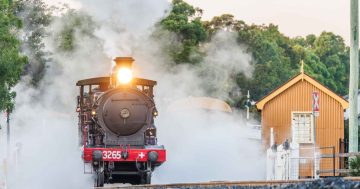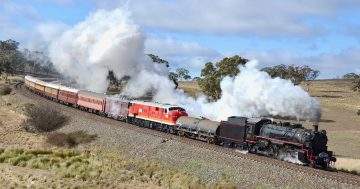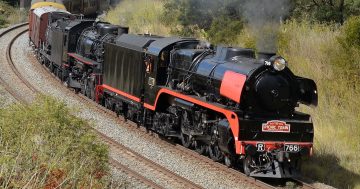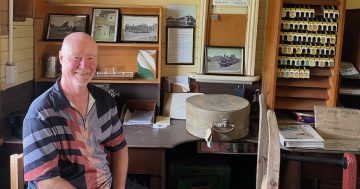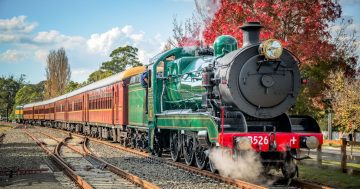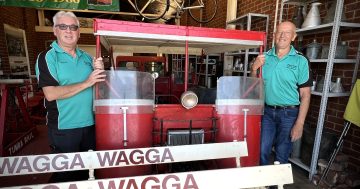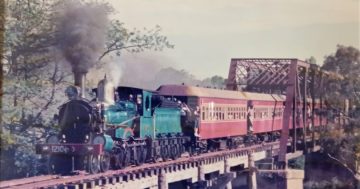
The news that a steam locomotive will return to Cooma Railway next month is exciting for Vicki Schoo, whose late father Alf Gammon drove the last steam engine between Cooma and Bombala. Photo: Gail Eastaway.
Cooma Monaro Railway (CMR) has announced that NSW Railways steam locomotive 3203 will arrive at its new home in Cooma on 10 May.
The locomotive was last in action in Cooma in 1973.
It has been cosmetically restored at Broadmeadow by Transport Heritage NSW volunteers.
The locomotive will be transported by road from Broadmeadow to Cooma, where it will be unloaded by crane and shunted into its temporary storage shelter on Goods Road No. 3, on the eastern side of the Goods Shed in Cooma yard.
The news of the “return” of steam to Cooma railway station is especially poignant for Vicki Schoo, whose late father Alf Gammon drove the last steam engine between Cooma and Bombala.

Steam locomotive 3203 will become a feature of Cooma Monaro Railway’s historic display at Cooma Railway Station from next month. Photo: Cooma Monaro Railway.
Alf’s story forms part of the railway history on display at the railway museum, which opened at the station on 10 December, 2022.
Vicki said of the return of the loco: “I actually think it is a great initiative for the railway guys, I expect that was a sizeable investment for them!
“The fact that it is based in Cooma will only increase the appeal of the museum and with the access to the restored station for all of the train lovers out there, I think the community as a whole will benefit from the purchase. It is exciting.”
In the meantime, CMR volunteers are eagerly working on preparations for the arrival, which includes the establishment of an access path that will allow visitors to the Cooma Monaro Railway Museum to view the locomotive up close.
These paths will also be extended to the loco shed, providing visitors with access to a fleet of CPH Railmotors.
CMR president Gordon Strachan said: “This will be the first time a steam locomotive has graced these tracks for almost 35 years, and we are really excited to see this beautiful piece of railway heritage make its way down to its new home in Cooma.
“We would like to thank the NSW Government, Transport for NSW and Transport Heritage NSW for their continued support in developing heritage railways in NSW.
“We would also like to take this opportunity to thank all the volunteers from Transport Heritage NSW and Cooma Monaro Railway, who have worked so hard to make this possible, from its restoration in Broadmeadow to the replacement of sleepers in sidings at Cooma and construction of its temporary shelter.
“It’s exciting times for the future of the heritage railway in the Monaro and we will have more big announcements coming soon. Stay tuned!”
Cooma Railway was an important part of the local community and economy for nearly 100 years.
Cooma station and its railway link from Queanbeyan NSW was completed in 1889, with the southern extension to Bombala completed in the early 1920s.
As the gateway to the Snowy Mountains area, Cooma was a key Monaro destination for almost 100 years of rail services, until the line from Canberra was closed by flood damage to the bridge over the Numeralla River in 1989.
During its service, the line was used to convey numerous tourists to the ski fields in the winter and many recreational fishermen and women for trout fishing in the warmer months.
Freight was always the big dividend for the railways, and Cooma railway yard was busy with goods arriving for the Snowy Hydro Scheme, and plenty of wool-laden wagons heading back to Sydney.
For 10 years there were no trains to be seen in the Monaro area, until CMR began operations in December 1998.
Services were run by CPH-class railmotors, of which CMR has three (CPH 6, 8 and 22). They also have CTC 55, which is a matching carriage to the CPH class, with a driver’s compartment at one end.
In 2014, CMR ceased rail operations due to the decaying state of the track north from Cooma to Chakola.
Since then, CMR has undertaken considerable work to repair, restore and upgrade the infrastructure with the Cooma Railway Station Precinct, with the result of the museum opening last year.
CMR has been sourcing funds to repair the track from Snowy Junction (adjacent to the Cooma Racecourse) south through to Rock Flat, which will allow CMR to resume heritage rail operations. Heading south to Rock Flat rather than returning north to Chakola means significantly less asset maintenance.







